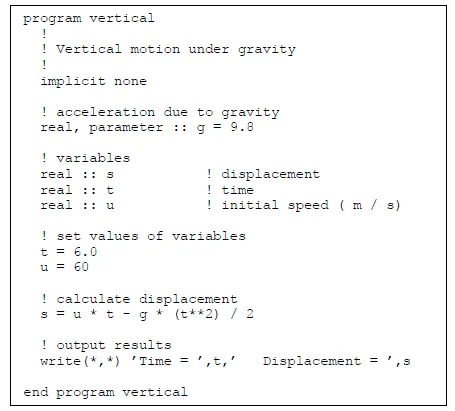Names in Fortran 90
Names or identifiers must adhere to the following rules:
cannot be longer than 31 characters
must be composed of alphanumeric characters and underscores
first character must be a letter
Good thing: identifiers are case-insensitive
A variable is a data whose values can be changed, unlike constants. They have similarity though, both variables and constants have a type, which can be one of the 5 intrinsic types, or a derived type.
5 intrinsic types:
Integer type:
Real type: real type and double precision
Complex type
Logical type: two logical values: .true. and .false. (yes, there are dots defending true and false)
Character type: characters and strings
Consider the following program for the illustration of the concept of variables, constants and types:

- literal constants: a constant value without a name
- named constants: a constant value with a name, named constants and variables must be declared at the beginning of a program in a so-called type declaration statement. Named constants must be declared with the “parameter” attribute:
Example:
real, parameter:: pi=3.1415927
Variables
Variables should be declared at the beginning of a program in a type declaration statement:
Example:
integer :: total
real::average1, average2 ! this declares 2 real values
complex:: cx
logical :: done
character(len=80):: line ! a string consisting of 80 characters
then after the declaration, this statements can be used as:
Example:
total = 6.7
average1=average2
done=.true.
line = “this is a line” ! characters are enclosed in a double quotes (“)
cx = cmplx(1.0/2.0, -3.0) ! cx = 0.5 – 3.0i, one has to use cmplx it is an intrinsic function
Arrays
Array is a collection of variables of the same type. Arrays can be 1D (like vectors in math), 2D (matrices) up to 7D. Arrays are declared with the dimension attribute:
Examples:
real, dimension(5)::vector ! 1-dim, real array containing 5 elements

integer, dimension(3,3)::matrix !2-dim. Integer array

Elements of an array can be referenced by specifying their subscripts.
Example:
- 1st element of the vector is, vector(1)
- row 1, column 1 of a matrix is matrix(1,1)
Character Strings
- concatenation: character(len=*), parameter :: & state=”Michigan’, name=”tech”
characteract(len=12):: schoolschool = state // name! // is used to concatenate state and name producing “michigantech”